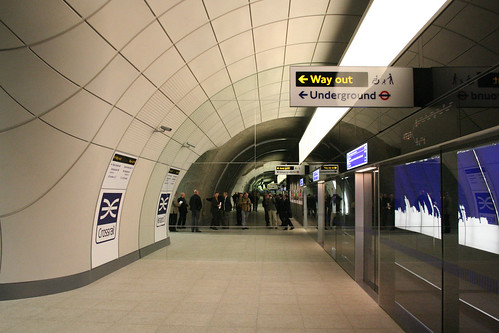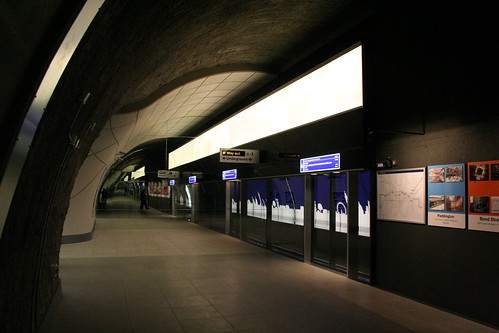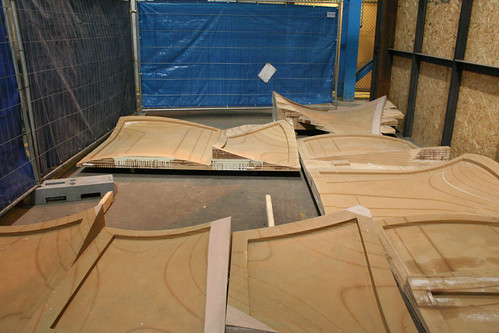A few months ago I stood in the Building Centre and looked at a tiny model of a Crossrail station with tiny model people inside. Yesterday I stood inside a model of a Crossrail station.
No, I haven’t been shrunk down into a miniature me – Crossrail has expanded that tiny model into a huge full-sized model for testing and built it in a warehouse in the Bedfordshire countryside. And along with a few other people, I got to go and have a play with it. Well, play as in have a look, take photos, get lots of questions answered and generally gawp at the place.
What we were to see is what they call a “1st stage mockup” which is built to test many of the concepts they want to use on the future stations and try to iron out any glitches before they commit to the final designs.
It’s quite important to remember that this is a mock-up and while the overall idea is finished, many of the details are still to be agreed on.
Although the mock-up is to test the final finished designs, the actual stations will be built “backwards” from the original plans. The original idea was to dig the large platform tunnels, then when the tunnel boring machines (TMB) arrived, drag it through the finished space them carry on tunnelling at the other end.
Now, they will just run the TBM right along and then enlarge the tunnel afterwards to turn it into a station. That was proposed by the tunnellers and means their time-scales are not affected by the station works, and should save money and reduce delays. It also has the huge benefit that the soil dug out from the platforms and escalators can be taken away along the tunnel that already exists. Far fewer trucks on the roads.
Anyway, back to the large warehouse…
Going through a tiny door in a wooden structure, you suddenly walk into a vast space that is sufficiently life-like that apart from the mirrors at each end, you do actually slightly forget that you are not deep underground, but standing inside a steel frame a metre or so off the ground.
The first things that hit you as you look around is the sheer size of the station platforms – a good 1.5 meters wider than a modern Jubilee Line platform, and double the width of many older tube platforms. As it is a tube tunnel, wider platforms (and trains) means much higher ceilings. While they say that the real tunnels will lose some of the height impression as they will be longer than the mock-up, it will still be a double-storey height space that makes a big difference to the older tiny tunnels we are more used to.
The other big difference is that apart from the Way Out signs, no other signs will protrude from the walls – all other signs will be on the walls, or above the glass doors. The concept, I personally think works incredibly well – although I do wonder if the destination boards above the doors will encourage people to huddle right in front of the doors, and if putting them between doors might be better. But, that is the point of a mock-up, to test these ideas.
The other advantage of the new displays is that they will be screens which act more like computer displays than old dot-matrix boards, so can be much more dynamic in what information they show.
For example – if something dire happened – then the screens can switch over to LARGE warning signs. The same idea is being thought of for the inevitable advertising signs that will be mounted behind the glass walls.
Looking above the glass wall/sliding doors and the thin black strip for destination boards (and route maps), is a large glowing strip that will light up the platform. At last, no more pockets of light and dark along the platforms as the whole length gets the same levels of illumination.
The light wall being roughly a meter high, but only a few inches thick therefore hides all the ventilation ducts and cabling, so those shouldn’t intrude into the passenger space. Talking of ventilation, yes the stations will be air-cooled. Technically not air-conditioned due to the lack of dehumidifying, but ventilated with cooled air.
The end result of hiding all the ducts and cables, is a large empty space above the passenger’s heads unimpeded by the usual detritus of tube stations with lights, security cameras, hanging signs or other messy clutter.
The flooring is an experiment as well – testing Terrazzo and Granite – and they will be putting down some samples in Victoria Station shortly to test them for wear-and-tear in a real passenger environment. So, in an odd sort of way, a real bit of a Crossrail station will be feeling the stomp of passengers feet rather sooner than most of us would have expected.
The interior will be entirely clad in the panels you can see on half of the mock-up. Although I personally quite like the sprayed concrete effect, it is a nightmare to clean and a pile of lawsuits from grazes and cuts just waiting to happen. It was just left on show here to explain the construction method used to make the station tunnels.
It also means the final station will be brighter than some of the photos suggest as you have pale walls reflecting the light instead of dark concrete absorbing it.
Incidentally, the panels for the mock-up were formed in wooden moulds built by a company that also does work for Formula 1 racing cars.
If you look at the area where the side tunnel links onto the platform, you will notice how it curves. This encourages passengers to “fan out” from the side passages as they enter the platform, rather than huddle right by the junction – or if they do huddle, at least it will be much easier to get past them.
It’s a very tidy and spacious experience, and I think people will be justifiably impressed when they first see it.
Which might be sooner than you think, as Crossrail is quite keen to somehow – and it’s not as easy as you might think – pack up the fake station and plonk it down somewhere in London for the public to look at. Although that is still a speculative idea, it is generally agreed that it would be a popular “tourist attraction” for Londoners.
After all, some of us had travelled outside the M25 to have a look. But then we are sad transport geeks!
If they do manage to get it down to London, have a close look at the railway tracks – they are just some old rusting rails they found, and to make them look new and shiny, they covered the tops of the rails in rolls of baking foil from the local supermarket!
You can read more over at London Reconnections, and there is a very short video clip from the BBC.
Even more photos over at my Flickr account.
PS.
Here is a photo from the Crossrail press office of the mock-up being built, which might give a better impression of the size of the tunnel.













[…] The “fake Crossrail tube station” hidden in a rural warehouse […]